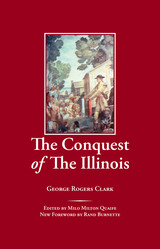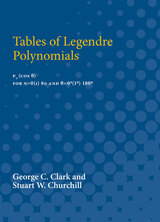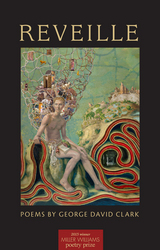
Written only a decade after George Rogers Clark’s conquest of Illinois, this firsthand account shows the region as it existed in the 1770s, explains how British occupation affected Kentucky settlers, and exhibits Clark’s enormous diplomatic skills in convincing the French settlers and Indians along the rivers of Illinois that they were better off under the jurisdiction of the Americans rather than the British. In his new foreword to this book, Rand Burnette refers to Clark as a psychologist and an expert in human relations.
Believing the British responsible for Indian raids on the people of Kentucky, Clark determined to capture that area, which was claimed by his home state of Virginia. “His plan, which he presented to Governor Patrick Henry,” Burnette notes, “was to take possession of the Illinois country by defeating the British at Kaskaskia, win the support of the French in that area, and thus control both the Mississippi and the Ohio Rivers. The British support of the Indians, who raided the Kentucky settlements from the Illinois country, would be at an end.”
Clark’s stirring narrative—written between 1789 and 1791 and covering 1773–1779—chronicles the events in the Old Northwest in the second half of the eighteenth century. Life on the frontier was dangerous and uncertain at this time. As Clark points out and Milo Milton Quaife underlines in his footnotes, death came to many at the hands of Indians or in military battles and skirmishes.
First published in 1920 and long out of print, the Quaife edition of Clark’s The Conquest of The Illinois reprinted here is for the modern reader superior to the original. First, Quaife provided an index. Equally important for modern readers, he standardized Clark’s spelling. (Clark had little formal education, and his spelling was even more eccentric than that found in a typical eighteenth-century account.) Finally, Quaife’s footnotes often include biographical sketches of the people in the book.

Ralph Waldo Emerson, the man and thinker, will be fully revealed for the first time in this new edition of his journals and notebooks. The old image of the ideal nineteenth-century gentleman, created by editorial omissions of his spontaneous thoughts, is replaced by the picture of Emerson as he really was. His frank and often bitter criticisms of men and society, his “nihilizing,” his anguish at the death of his first wife, his bleak struggles with depression and loneliness, his sardonic views of woman, his earthy humor, his ideas of the Negro, of religion, of God—these and other expressions of his private thought and feeling, formerly deleted or subdued, are here restored. Restored also is the full evidence needed for studies of his habits of composition, the development of his style, and the sources of his ideas. Cancelled passages are reproduced, misreadings are corrected, and hitherto unpublished manuscripts are now printed. The text comes as close to a literal transcription as is feasible. A full apparatus of annotation, identification of quotations, and textual notes is supplied. Reproduced in this volume are twelve facsimile manuscript pages, many with Emerson’s marginal drawings.
The first volume includes some of the “Wide Worlds,” journals begun while Emerson was at Harvard, and four contemporary notebooks, mostly unpublished. In these storehouses of quotation, juvenile verse, themes, and stories are the first versions of Emerson’s “Valedictory Poem,” Bowdoin Prize Essays, and first published work. Together they give a faithful picture of Emerson’s apprenticeship as an artist and reveal the extent of his hidden and frustrated ambition—to become a writer.


READERS
Browse our collection.
PUBLISHERS
See BiblioVault's publisher services.
STUDENT SERVICES
Files for college accessibility offices.
UChicago Accessibility Resources
home | accessibility | search | about | contact us
BiblioVault ® 2001 - 2024
The University of Chicago Press









